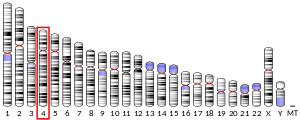FRAS1
Extracellular matrix protein FRAS1 is a protein that in humans is encoded by the FRAS1 (Fraser syndrome 1) gene.[5][6] This gene encodes an extracellular matrix protein that appears to function in the regulation of epidermal-basement membrane adhesion and organogenesis during development.
Clinical significance
Mutations in this gene have been observed to cause fraser syndrome.[7]
gollark: No, your connection is fine, Discord would say if a message had not actually sent.
gollark: And send the events on the connections somehow.
gollark: Your backend server for this will have to accept websocket connections.
gollark: https://wiki.computercraft.cc/Http.websocket
gollark: Nope!
See also
References
- GRCh38: Ensembl release 89: ENSG00000138759 - Ensembl, May 2017
- GRCm38: Ensembl release 89: ENSMUSG00000034687 - Ensembl, May 2017
- "Human PubMed Reference:". National Center for Biotechnology Information, U.S. National Library of Medicine.
- "Mouse PubMed Reference:". National Center for Biotechnology Information, U.S. National Library of Medicine.
- "Entrez Gene: Fraser syndrome 1".
- McGregor L, Makela V, Darling SM, Vrontou S, Chalepakis G, Roberts C, Smart N, Rutland P, Prescott N, Hopkins J, Bentley E, Shaw A, Roberts E, Mueller R, Jadeja S, Philip N, Nelson J, Francannet C, Perez-Aytes A, Megarbane A, Kerr B, Wainwright B, Woolf AS, Winter RM, Scambler PJ (June 2003). "Fraser syndrome and mouse blebbed phenotype caused by mutations in FRAS1/Fras1 encoding a putative extracellular matrix protein". Nat. Genet. 34 (2): 203–8. doi:10.1038/ng1142. PMID 12766769.
- "Fraser syndrome 1". February 23, 2010. Retrieved May 17, 2010.
Further reading
- Short K, Wiradjaja F, Smyth I (2007). "Let's stick together: the role of the Fras1 and Frem proteins in epidermal adhesion". IUBMB Life. 59 (7): 427–35. doi:10.1080/15216540701510581. PMID 17654118.
- Long J, Wei Z, Feng W, et al. (2008). "Supramodular nature of GRIP1 revealed by the structure of its PDZ12 tandem in complex with the carboxyl tail of Fras1". J. Mol. Biol. 375 (5): 1457–68. doi:10.1016/j.jmb.2007.11.088. hdl:10397/14647. PMID 18155042.
- Gerhard DS, Wagner L, Feingold EA, et al. (2004). "The status, quality, and expansion of the NIH full-length cDNA project: the Mammalian Gene Collection (MGC)". Genome Res. 14 (10B): 2121–7. doi:10.1101/gr.2596504. PMC 528928. PMID 15489334.
- Jugessur A, Shi M, Gjessing HK, et al. (2010). "Maternal genes and facial clefts in offspring: a comprehensive search for genetic associations in two population-based cleft studies from Scandinavia". PLoS ONE. 5 (7): e11493. Bibcode:2010PLoSO...511493J. doi:10.1371/journal.pone.0011493. PMC 2901336. PMID 20634891.
- Ota T, Suzuki Y, Nishikawa T, et al. (2004). "Complete sequencing and characterization of 21,243 full-length human cDNAs". Nat. Genet. 36 (1): 40–5. doi:10.1038/ng1285. PMID 14702039.
- Medland SE, Nyholt DR, Painter JN, et al. (2009). "Common variants in the trichohyalin gene are associated with straight hair in Europeans". Am. J. Hum. Genet. 85 (5): 750–5. doi:10.1016/j.ajhg.2009.10.009. PMC 2775823. PMID 19896111.
- Vrontou S, Petrou P, Meyer BI, et al. (2003). "Fras1 deficiency results in cryptophthalmos, renal agenesis and blebbed phenotype in mice" (PDF). Nat. Genet. 34 (2): 209–14. doi:10.1038/ng1168. PMID 12766770.
- Strausberg RL, Feingold EA, Grouse LH, et al. (2002). "Generation and initial analysis of more than 15,000 full-length human and mouse cDNA sequences". Proc. Natl. Acad. Sci. U.S.A. 99 (26): 16899–903. Bibcode:2002PNAS...9916899M. doi:10.1073/pnas.242603899. PMC 139241. PMID 12477932.
- Kimura K, Wakamatsu A, Suzuki Y, et al. (2006). "Diversification of transcriptional modulation: large-scale identification and characterization of putative alternative promoters of human genes". Genome Res. 16 (1): 55–65. doi:10.1101/gr.4039406. PMC 1356129. PMID 16344560.
- Docherty SJ, Kovas Y, Petrill SA, Plomin R (2010). "Generalist genes analysis of DNA markers associated with mathematical ability and disability reveals shared influence across ages and abilities". BMC Genet. 11: 61. doi:10.1186/1471-2156-11-61. PMC 2909150. PMID 20602751.
- Gattuso J, Patton MA, Baraitser M (1987). "The clinical spectrum of the Fraser syndrome: report of three new cases and review". J. Med. Genet. 24 (9): 549–55. doi:10.1136/jmg.24.9.549. PMC 1050267. PMID 3118036.
- van Haelst MM, Maiburg M, Baujat G, et al. (2008). "Molecular study of 33 families with Fraser syndrome new data and mutation review". Am. J. Med. Genet. A. 146A (17): 2252–7. doi:10.1002/ajmg.a.32440. PMID 18671281.
- Nagase T, Kikuno R, Ishikawa K, et al. (2000). "Prediction of the coding sequences of unidentified human genes. XVII. The complete sequences of 100 new cDNA clones from brain which code for large proteins in vitro". DNA Res. 7 (2): 143–50. doi:10.1093/dnares/7.2.143. PMID 10819331.
This article is issued from Wikipedia. The text is licensed under Creative Commons - Attribution - Sharealike. Additional terms may apply for the media files.



